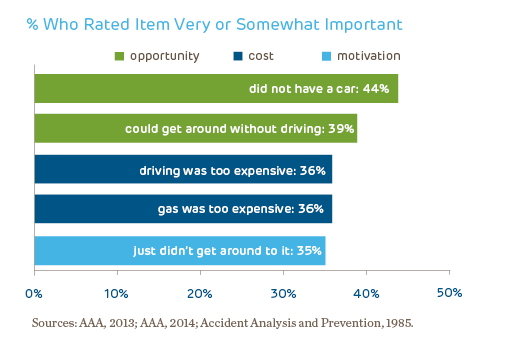At least one in three novice drivers waits until after turning age 18 to pursue getting licensed to drive, mostly for reasons related to opportunity, cost, and motivation (see graph below), according to a recent study from the AAA Foundation for Traffic Safety. This can be a very sensible and practical decision to wait until an individual is ready to begin the learning-to-drive process and can afford the costs associated with it.

Unfortunately, in most states Graduated Driver Licensing (GDL) ends by age 18 and therefore cannot provide older novice drivers with the protective benefits of GDL. All novice drivers under 21 years of age have a higher risk of crashing no matter what their age when first learning to drive. To keep these older new drivers safe, families should create a Personal GDL Plan.
A Personal GDL Plan for Older New Drivers
Follow these steps to take ownership of the learning-to-drive process for older novice drivers:
- Prepare for the learner permit. Read up on your state's traffic laws and know the stages of GDL. Learn more.
- Consider getting behind-the-wheel training with a professional. High quality driver education and effective parent-supervised driving practice are key to preventing teen crashes, the number one cause of death for adolescents in the U.S. Learn more.
- Designate an experienced licensed adult driver to supervise practice driving. CHOP researchers have developed the TeenDrivingPlan Practice Guide, an evidence-based guide to help parents effectively supervise the learning-to-drive process. Learn more.
- Follow supervised practice with independent driving under less risky conditions before driving in high-risk conditions. Also, continue to enlist an adult to ride along as a passenger to provide guidance in difficult driving situations until experience is gained. Learn more.
Learn about advocacy efforts to improve GDL and protect older new drivers.